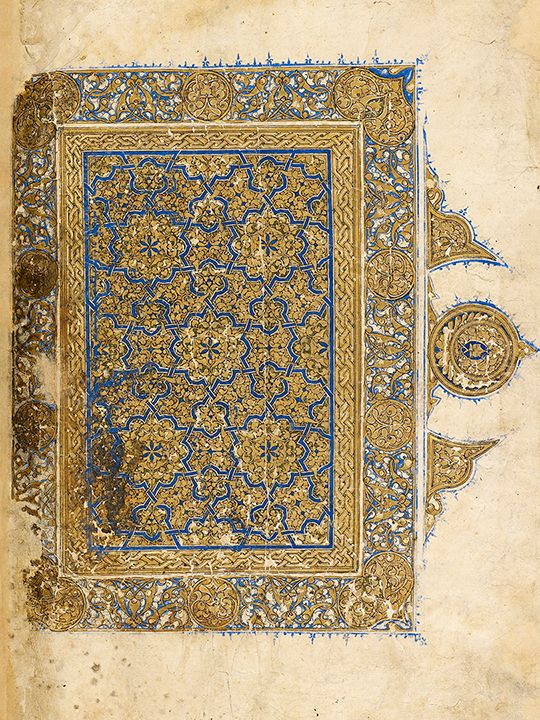
Abu Dhabi: In a quiet, atmospherically-lit gallery in Wing 2 of Louvre Abu Dhabi, one of four within the museum’s masterful spaces, visitors will find fascinating artefacts from the world’s sacred texts.
These artefacts narrate the story of universal religions that emerged over 2,000 years ago, spreading across Europe, Asia, and Africa within just a few centuries. By addressing their messages to all humanity without distinction, these religions transcended local cultural characteristics and profoundly transformed communities that thrived during antiquity.

These religions shared the idea of monotheism – the belief in one God - but differed on their representation of the divine. While their roots lay in ancient religions, the rise of universal religions marked a unifying force that brought communities together and influenced intellectual and artistic pursuits across continents.
Among Louvre Abu Dhabi’s sacred texts is the Juz’ Amma, the 30th section of a Holy Quran, dating from approximately 1250–1300 CE, during the Mamluk Dynasty. “This section probably originating from Syria was acquired by the museum in 2009,” explains Mariam AlDhaheri, a curatorial assistant at Louvre Abu Dhabi. “The exhibits in Gallery 4, which is dedicated to Universal Religions, truly embody the museum's narrative. They showcase different cultures side by side throughout history, highlighting their commonalities.”

Unique narrative
AlDhaheri has honed her expertise in conveying Louvre Abu Dhabi’s unique narrative to global audiences. Her close to 10-year career began in the museum’s communications department, where she introduced international journalists to the museum’s unique curatorial approach. The first universal museum in the Arab world, Louvre Abu Dhabi showcases artworks from different cultures side by side. It tells stories of human creativity that transcend civilisations, geographies, and times, fostering understanding across cultures. “As someone who is half Emirati and half French, I grew up visiting the Musée du Louvre in Paris with my grandmother. Being part of Louvre Abu Dhabi’s story is a profound privilege; the museum feels like a part of my identity,” she says.

The Juz’ Amma, in Louvre Abu Dhabi’s collection is the final Juz in the Holy Quran and its chapters, or Suras, are written on paper in ink and decoratively illuminated in gold. “This kind of work may have taken a lifetime to produce by the calligrapher who worked on it,” explains AlDhaheri. “There would have been an artist working on the illuminations and when you think that they could not make one mistake at the risk of having to start again, it was a slow and painstaking task.” For Muslim calligraphers, their art was also a genuinely spiritual experience bound in honour, as they carefully formed the different calligraphic styles - Kufic, characterised by its angular letters, and the cursive forms of Naskh.
Sacred texts
The Quran shares its gallery with sacred texts and scriptures from other religions including a Bible and a Torah. According to AlDhaheri, this arrangement complements the nearby Abrahamic Family House in Saadiyat Cultural District. “Both the gallery and the Abrahamic Family House symbolise the shared values of Islamic, Christian and Jewish faiths as well as our universal message of diversity, mutual respect, and knowledge sharing,” she says.

This journey through the foundational texts of faith was celebrated last year at Louvre Abu Dhabi in the Letters of Light (13 September 2023 - 14 January 2024) exhibition. The exhibition showcased some of the most exquisite sacred books ever created, highlighting the work of skilled calligraphers, bookbinders, and artists who used precious pigments and illuminated calligraphy. Featuring over 240 artefacts, Letters of Light demonstrated how the production techniques and designs of sacred texts evolved over centuries, reflecting shared artistic influences among the three major religions.
Preservation process
As for the precious Section from a Quran in the museum’s Universal Religions gallery, it is currently being rested as part of a meticulous preservation process. Visitors can still explore its history through digital displays in the gallery, which provide images and descriptions of the text during its hiatus. “We rotate sensitive ancient artefacts including manuscripts three times a year to ensure they are stored in ideal environmental conditions,” AlDhaheri explains. “The gallery’s subdued lighting also protects these works. They are not just for our generation; we aim to preserve them for centuries to come.”

The Louvre Abu Dhabi’s Research Laboratory plays a vital role in conserving artefacts for future generations, advancing both art historical research and preservation science. “It’s essential and deeply fulfilling work,” says AlDhaheri. The museum also inspires young people to pursue careers in cultural industries. “My friend Moza Alnaqbi, an assistant researcher, works in the lab, while Noora Alzaabi, a documentation photographer, uses scientific photography to uncover artifact layers. Additionally, my artist friends, Aisha AlAhmadi and Maitha Alomaira, have joined the curatorial team,” she adds.
“Louvre Abu Dhabi empowers young Emiratis to build careers in cultural industries, fulfilling its mission, and that of the Saadiyat Cultural District, to advance knowledge, creativity, and cultural exchange.”
- In collaboration with Saadiyat Cultural District Abu Dhabi












